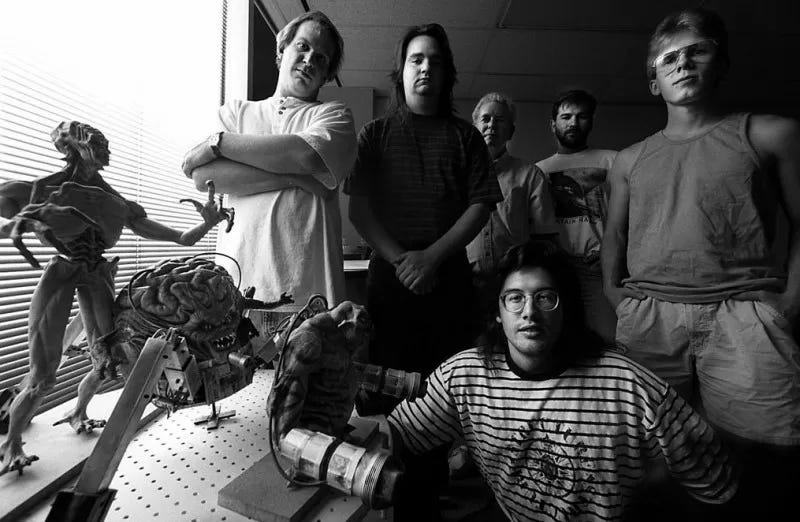Masters of Disruption: How the Gamer Generation Built the Future [3]
John Romero has seen the future of the metaverse, and it's not Snow Crash.
This post is part of a new “book” I’m serializing exclusively in my newsletter, Disruptor. It’s a follow-up to my first book, Masters of Doom: How Two Guys Built an Empire and Transformed Pop Culture, and it’s called Masters of Disruption: How the Gamer Generation Built the Future. To follow along, please subscribe below. Thanks!
John Romero, the original rockstar of videogames, is right where you’d expect him to be: chilling on the balcony of a mansion with a camera crew in tow. The co-creator of the groundbreaking shooter franchises Wolfenstein 3-D, Doom, and Quake, is hosting a documentary series called New Reality, in which he chats with leading technologists. Romero fist bumps his latest interviewee Nick Fajt, CEO of Rec Room, as they discuss how Fajt’s company is building an online multiplayer experience in virtual reality.
The conversation is taking place within Rec Room’s VR world. Romero’s cartoon torso and head, complete with his trademark long, black, heavy metal hair, float around the estate as he gesticulates with his disembodied hands. The two teleport to a paintball range, where Fajt says gamers have made Doom character costumes in Romero’s honor. With an appreciative laugh, Romero slips into a Cacodemon skin, and starts firing away.
Nearly every aspect of this experience—from the multiplayer deathmatching to the immersive virtual world—is something Romero helped pioneer. As the co-founder of id Software, Romero and his partners ushered in the modern era of gaming, from esports to first person shooters, from multiplayer to the very idea of immersive 3D environments.
His partnership with id co-founder John Carmack, whom I caught up with in my previous post for Masters of Disruption, is the stuff of legend, and the subject of my first book, Masters of Doom: How Two Guys Built an Empire and Transformed Pop Culture.
Like The Two Steves, Apple’s co-founders Jobs and Wozniak, The Two Johns remain one of technology’s greatest dynamic duos. They’ve been called the Lennon and McCartney of videogames, though the guys who cited Evil Dead II and Aliens as the main influences for Doom, are way more like Slayer.
What made the collaboration extraordinary was Romero’s ability to see the potential of Carmack’s innovations when no one else could. Some of the most endemic parts of gamer culture and industry today began with Romero glancing down at Carmack’s computer screen and declaring that “this is the coolest fucking thing planet Earth has ever seen!”
To wit:
After Carmack discovered how to program a Mario-like side-scrolling game on a PC, Romero saw how they could turn it into hits of their own. They pulled this off with their next game, Commander Keen.
In 1993, when Romero first played Doom against Carmack across a network, he coined both the word and the gameplay mode of “deathmatch.”
Romero pioneered the idea of licensing game engines, now common practice, in the summer of 1991.
In the decades since leaving id Software, Romero continued to iterate with what each new technology allowed. Though the results weren’t always critically and commercially successful, his timing has been spot on: launching one of the first mobile games companies, Monkeystone, in 2001; co-founding a massively multiplayer online gaming company, Slipgate, in 2005; and releasing a hit Facebook game, Ravenwood Fair, with his wife, Brenda Romero, in 2010. He continues to make games, releasing an acclaimed mobile title, Gunman Taco Truck, designed by his 9-year-old son in 2017. His company, Romero Games, recently published a Prohibition-era mobster strategy RPG Empire of Sin.
Today, the 53-year-old disavows his notorious days of shilling in ads for his own games and assorted joysticks. He leads a quieter life making and playing games with his wife, veteran game designer Brenda Romero, at their company in Galway, Ireland. In speeches to schools and companies around the world, he has embraced the role of Wise Gaming Elder, sharing his insights into the past and future of what’s now a $450 billion dollar global industry, and as much a part of the cultural conversation as TV or pop music.
Romero shares only an occasional email with Carmack these days. But, after talking with them both, I found them similarly contrarian about one of gaming’s most hyped-up futures: the metaverse.
“The metaverse is not Snow Crash. It's going to be something different.”
Like Carmack and legions of other visionary coders, Romero initially imagined that the metaverse would resemble the virtual dystopia divined in Neal Stephenson’s seminal 1992 sci-fi novel, Snow Crash. “It’s funny, because the metaverse envisioned in Snow Crash is like a city, right?” He tells me, “This strange city that's basically cyberpunk, like a place to live.” But now,he thinks reality is heading in another direction.
“The metaverse is not the direct representation that you would imagine from Snow Crash," he predicts, “It's going to be something different.”
Also, Carmack told me that he thinks the future of the metaverse is embedded in videogames of today. While Carmack sees Fortnite and Minecraft as portals to the metaverse. Romero catches the same glimpse in the massively multiplayer online game, World of Warcraft. WoW has been around for 17 years now, and has hundreds of players interacting on the same server. “WoW is probably the closest just because of all the people in it,” he says, “I think that we've already been touching the metaverse.”
Romero explores the Rec Room virtual world
One place he touched the metaverse, he says, is inside Rec Room. First released for Windows in 2016, Rec Room now boasts over 15 million players, and has earned a $1.25 billion evaluation. Filming the documentary inside the virtual world felt like a taste of the future to him.
“We can see that the virtual cameras are there and there are cameramen,” Romero tells me, “So they're basically giving orders to go up the stairs and we have to walk up the stairs with them. It's just like you would do a real shoot in real life, but it's all virtually directed, and it's happening. This is a metaverse-y thing.”
“Virtual reality isn’t the killer app for the metaverse.”
One aspect of this Rec Room experience that isn’t necessarily so metaverse-y, he thinks, may come as a surprise: virtual reality. From Johnny Mnemonic to Ready Player One, it’s often imagined that we’ll be exploring the metaverse with goggles on our faces, Romero predicts VR will be just one means of access. This is already the case with Rec Room, which is available on VR as well as computer and phone screens. “I don't think virtual reality is the killer app experience for the metaverses,” Romero says.
Romero is still waiting for the experience that defines the metaverse, just as Doom defined PC gaming. But he’s fairly certain that its future is in the palm of your hand. “Your phone is going to be the first portal into it,” he says, “because it's the thing that everyone's comfortable with as an input.”
He also thinks that, when it happens, the leap into the metaverse won’t seem like such of a leap at all. “At some point, it will coalesce,” he says, “and it'll be something that feels very natural to everybody.”









